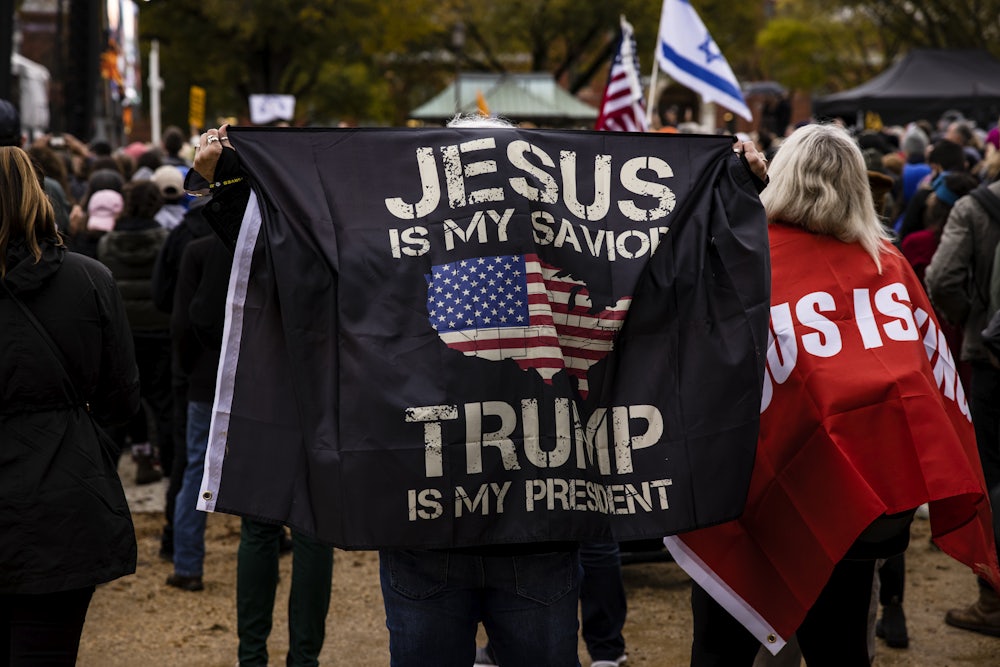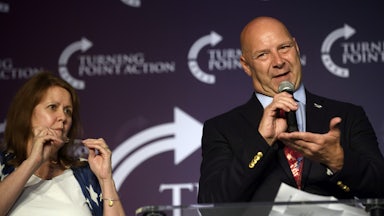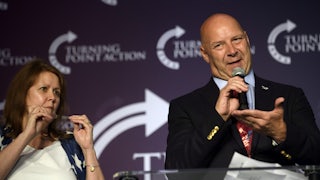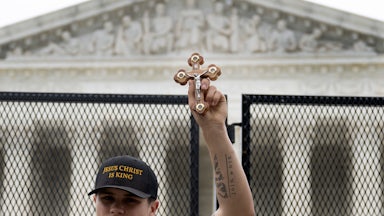Recent data analysis by Pew Research looked at the future of Christianity in the United States, and what it found was startling. By sometime around 2045, only about half of Americans could identify as Christian. If trends continue, it could fall to as little as 35 percent by 2070, and certainly no more than 54 percent. Simultaneously, the rise of the “nones” means there will likely be as many Americans with no religion by then.
There have been plenty of articles by very serious people who wring their hands and bemoan the loss of a common U.S. religion (and who ignore that there have always been Muslims, Jews, deists, atheists, agnostics, and other non-Christians here). Where will communities meet and bond? Where will morality come from? What will tie people together? However, such questions entirely miss the point that religion in this country has been a singularly divisive factor for well over a decade and is only becoming more so.
The numbers paint a clear picture of what is happening. As American youths leave home, they leave the faiths of their parents and never return. This is in great part because the teachings of most churches in the U.S. are fundamentally at odds with what young people believe: particularly on topics like abortion, marriage equality, birth control, and premarital sex. They simply fail to see how such out-of-touch institutions are relevant.
Consider these numbers. Among members of the 20 largest denominations in the U.S., approximately 88 percent (weighted by membership) oppose same-sex marriage. Liberal mainline denominations (such as Episcopalians and Unitarians) have been in steep decline for decades, and account for only a tiny fraction of the U.S. religious landscape. Other mainline denominations (like Methodists) still oppose same-sex marriage and abortion. These denominations, whatever their political bent, are so tiny after years of decline that they really only account for a couple points of the American population. Conversely, 88 percent of 18- to 29-year-olds believe that abortion should remain legal in some or all circumstances, per a recent Gallup poll. Even five years ago, support for same-sex marriage was 79 percent among this cohort, and it’s certainly higher now.
It also doesn’t help that major denominations have tarnished themselves with their handling of sexual harassment and assault. The Catholic Church, the Church of Jesus Christ of Latter Day Saints (Mormons), and the Southern Baptist Convention have all been repeatedly rocked with revelations of how they tolerate, mishandle, and cover up sexual misconduct and crimes.
The most crucial factor, though, is how Christianity has slowly become primarily a political identity for many (overwhelmingly conservative) people. Over the past 40 years, membership in nice, bland, mainline Protestantism has plummeted, from 30 percent of the public down to 10 percent. Conversely, evangelical membership (and the number of white evangelicals) boomed in the 1970s and ’80s and then slowly declined. But evangelical groups are still much larger than the mainline Protestant denominations, constituting about 23 percent of adults and up to 37 percent of Americans claiming to be “born again.” Because white evangelicals are one of the most consistently conservative groups in the country, the result is that people who identify as Christian or attend church frequently are far more likely also to identify as Republican.
Black churches have held steady for decades at about 8 percent of the population. They are still associated with social justice goals, but they can also tend toward social conservatism, which can produce tension. For example, the Black Lives Matter movement’s leadership featured many LGBTQ people, who had a somewhat limited or uneasy working relationship with churches. Latinos were traditionally part of the Catholic Church. However, traditionally white evangelical denominations have had some luck luring Latinos away with social conservatism and the false machismo projected by Republicans, which explains some of the electoral shift seen in 2020.
Just as those who attend church frequently tend to be Republican, the converse is also true: Those with no religion are far more likely to be Democrats. Data analysis by Ryan Burge shows that white evangelicals have had a stranglehold on the GOP for over two decades and form a clear majority of the GOP, alongside conservative Catholics. However, by 2018, the “nones” represented a plurality (28 percent) of Democrats, whose gains have come at the expense of evangelicals, mainlines, and Catholics within the party. Today, almost half of Gen Z has no religion, along with 51 percent of white women.
Polling data collected by Life Way Research (a subsidiary business of the Southern Baptist Convention) supports these suppositions. A 2017 survey of 2,002 U.S. adults age 23 to 30 who attended a Protestant church two times or more a month for at least a year in high school found that 66 percent had stopped attending church. Seventy percent of those cited religious, ethical, or political beliefs for dropping out. Other major reasons cited included hypocrisy, churches being judgmental, and a lack of anything in common with other people at the church.
The real danger of this widening schism is not a lack of shared sense of community, or people not doing enough charitable work. The danger lies in this creating the conditions for a future that looks more like present-day Russia or Iran.
Conservative Christians have a deep sense of victimhood and fear about a secular America and are willing to end democracy to prevent it. As David Frum noted, “If conservatives become convinced that they cannot win democratically, they will not abandon conservatism, they will abandon democracy.”
It has not gone unnoticed that Republicans are increasingly claiming the mantle of being Christian Nationalists. A recent poll found that although 57 percent of Republicans recognize that declaring the U.S. a “Christian nation” is unconstitutional, over 60 percent would support it. To achieve enforcement of an unpopular set of religious beliefs amid a population that is increasingly ambivalent or hostile to the dominant (conservative) strain of religion in the U.S., the GOP is already instituting increasingly undemocratic processes, insurrections, and efforts to overturn legitimate elections and is installing religious zealots in positions of power.
I feel like I should not have to write this, but having conservative religions joined at the hip with an authoritarian single-party state can only end badly. There are two awful examples literally in the headlines today.
First there is the Russian Orthodox Church, headed by Patriarch Kirill. He’s been one of Vladimir Putin’s most loyal allies and has been willing to put the church’s blessing on virtually anything Putin does. This includes supporting Russian actions in Ukraine in the name of stamping out the corrupting Western influence of homosexuality and protecting the Russky mir (Russian world). More recently, he has declared that dying in battle washes away all of one’s sins. Having a church that is simply another media arm for an authoritarian government is far from ideal. But at least the Russian population’s belief systems are still generally aligned with the dominant church. On top of the fascism, Russian Orthodox church leaders have made themselves obscenely wealthy by supporting Putin’s kleptocracy.
What we’re seeing in Iran is what happens when a sclerotic, gerontocratic, authoritarian theocracy tries to impose its will on a younger population that no longer accepts the legitimacy of the government and also rejects some of its core religious teachings. Protests erupted over 22-year-old Mahsa Amini being tortured and killed by “morality police” for wearing her hijab the “wrong” way. Women have responded by tearing off their head scarves and burning them. Men have attacked police, and riots have racked the country for weeks. The internet has been shut down, and at least 75 people have been killed so far. The Iranian regime has reportedly lost control of a predominantly Kurdish town on the border as well.
This is what the U.S. has in store if we continue along the path we’re going down: Christianity is becoming primarily a political identity in service of an ideology dedicated to creating a single-party theocratic state. If recent events are any guide, Christianity in the U.S. is on a path either to being little more than a corrupted tool of fascism (as in Russia) or becoming a violent, oppressive, and omnipresent force (as in Iran) against which the population can achieve change only through revolution.










